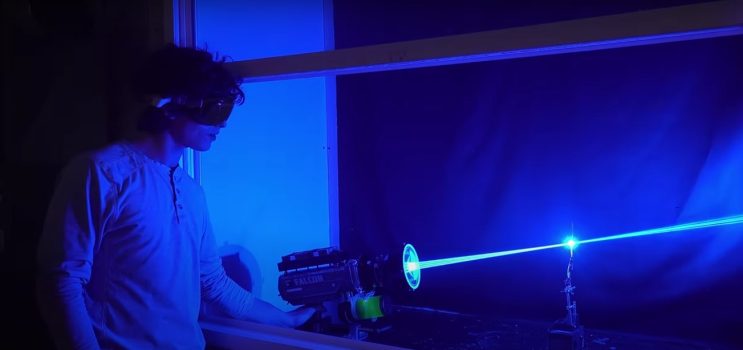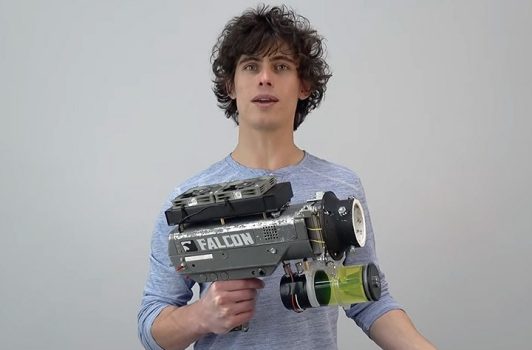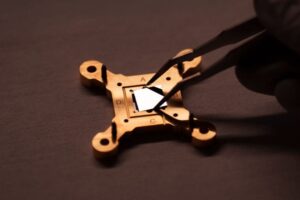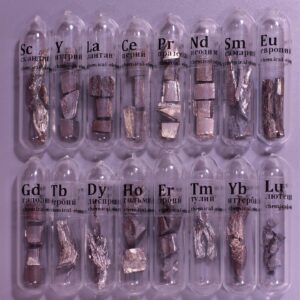 Pin
Pin Photo Courtesy of Drake Anthony
When a YouTube video titled “2025 world’s strongest handheld laser (I Built a Laser from Hell)” exploded across the internet, most people thought it was just another flashy DIY stunt. But as the footage rolled on, jaws dropped. The creator, known for pushing science to wild limits, showcased a real handheld laser that wasn’t just for show. This device could melt aluminum, shatter glass, and ignite cardboard like it was paper soaked in fuel.
The buzz began instantly. Online forums lit up, science geeks geeked out, and skeptics demanded proof. But there was no CGI here—just raw, fiery output from a homemade contraption. This wasn’t a movie prop or a trick of the light. It was an actual, functioning laser strong enough to earn the title: YouTuber Builds World’s Strongest Handheld Laser.
This video wasn’t just entertainment—it sparked debates around tech ethics, personal responsibility, and the fine line between innovation and danger. It made people ask: should anyone have access to such power outside a lab?
Table of Contents
Meet the Man Behind the Laser – Styropyro’s Wild Genius
 Pin
Pin Photo Courtesy of Drake Anthony
The mastermind behind the laser is Styropyro (Drake Anthony), a YouTuber known for mixing chaos with science in the most entertaining ways. He isn’t just some backyard tinkerer—he’s a legit laser hobbyist with years of experience, a background in physics, and a fan base that thrives on danger and curiosity. His lab? A modest, cluttered room stacked with warning labels, cooling fans, and enough batteries to rival a small power station.
What makes his build so intense is his approach. Styropyro doesn’t just buy parts—he salvages them from old tech, repurposes industrial components, and wires everything by hand. The result? A laser system that’s not just powerful—it’s terrifyingly efficient. It’s cooled with custom fans, powered by lithium-ion cells, and focused through lenses he manually aligned for deadly precision.
His goal wasn’t just power—it was portability. In a world where most lasers are stationary or require massive rigs, this one fits in your hand. That’s what makes it such a spectacle. YouTuber Builds World’s Strongest Handheld Laser isn’t just a clickbait title—it’s a serious engineering flex.
How the Laser Works?
At first glance, the laser looks like something pulled straight out of a sci-fi movie. But underneath the sleek casing and glowing beam lies a surprisingly understandable mechanism. The handheld laser is essentially a high-power diode laser—modified, optimized, and overclocked far beyond safe consumer levels. The key component is the laser diode, the same type used in DVD burners, but this one’s output is exponentially higher, peaking over 40 watts.
To handle the heat, Styropyro designed a cooling system using aluminum heat sinks and powerful computer fans. Without them, the device would fry itself in seconds. The battery pack delivers stable, high-current output, while the lens setup focuses the beam into a tight, lethal point. The entire build prioritizes raw energy output, with very little in the way of safety or insulation.
What’s fascinating is how accessible some of the components are. He sources them from consumer electronics and surplus suppliers. The catch? Putting them together safely takes serious know-how. YouTuber Builds World’s Strongest Handheld Laser because he knows exactly how to tame that energy—just barely.
Safety Concerns and the Legal Grey Area
The excitement around this handheld laser quickly sparked a different kind of conversation—how dangerous is it, and is it even legal? A device that can burn metal, cut plastic, and ignite flammable materials from several feet away sounds more like a weapon than a gadget. Laser safety experts weren’t impressed—they were alarmed. Class 4 lasers, like the one Styropyro built, are considered extremely hazardous and require strict handling protocols in professional environments.
In many countries, including the U.S., powerful handheld lasers exist in a legal grey area. There are federal guidelines, but enforcement is inconsistent. As long as a laser is labeled and not marketed for illegal use, hobbyists can often sidestep strict regulation. Still, this doesn’t make it safe. A misfired beam can cause permanent eye damage or even start fires.
That’s why the label YouTuber Builds World’s Strongest Handheld Laser isn’t just impressive—it’s risky. It raises questions about what should be shared online, how far creators should push boundaries, and the role platforms like YouTube play in moderating experimental content.
The Reaction – Internet Applause, Shock, and Backlash
Once the video went viral, reactions flooded in from every corner of the internet. Fans cheered the innovation, calling it “next-level science” and “mad genius at work.” Engineering students, DIYers, and tech enthusiasts swarmed the comments, begging for blueprints and tutorials. Memes popped up within hours, and Reddit threads dissected every frame like a forensic science lab.
But not everyone was cheering. Critics pointed out the obvious dangers. A few commenters accused the YouTuber of being reckless and irresponsible, arguing that this could inspire copycats without the skill to build or handle such devices. Others questioned YouTube’s role in amplifying such risky content. Some viewers reported the video, while others defended it under the banner of science and free expression.
The split was clear—half the internet saw the title YouTuber Builds World’s Strongest Handheld Laser as inspiring. The other half saw it as a dangerous precedent. But both sides agreed on one thing: this wasn’t a typical DIY project. It was a bold, controversial demonstration of what one person can do with enough knowledge—and nerve.
The Science Behind Burning Power – Why It Melts Metal
A big part of the shock value in YouTuber Builds World’s Strongest Handheld Laser comes from watching everyday objects disintegrate in seconds. But what’s really happening when the laser melts metal or lights a piece of wood on fire? It all boils down to focused energy density. When light is concentrated into a tiny point with high power, it delivers intense heat—enough to vaporize or ignite most materials.
The laser in the video emits a concentrated beam with an energy density that far exceeds the burning point of plastic, wood, and even thin metals like aluminum. Unlike a flame, which radiates heat outward, the laser targets its energy into a precise location. That’s why it cuts cleanly through soda cans and starts fires instantly.
The color of the beam also matters—shorter wavelengths (like violet or blue) tend to carry more energy. The beam’s tight focus, minimal dispersion, and massive output create a thermal effect so intense that it turns solid surfaces into liquid or gas. It’s not magic—it’s physics turned deadly efficient.
Building the Beast – Tools, Parts, and Resources
What makes the laser project even more fascinating is that Styropyro built it using parts many tech-savvy people could actually find. He didn’t rely on secret lab equipment or custom-manufactured components. Instead, he pieced it together using scavenged parts from old projectors, lithium battery packs, cooling fans, and laser diodes commonly found in high-end DVD burners or industrial machines.
His workbench is chaotic but intentional—wires neatly twisted, soldering tools always within reach, and safety goggles lying right next to the danger. He used high-capacity 18650 batteries to power the beast, with proper circuitry to handle the massive voltage draw. The cooling system was DIY too, with heat sinks pulled from discarded computers and retrofitted for his handheld laser’s specific dimensions.
The real skill lies in knowing how to make it all work together. One wrong connection, and the laser could fail—or worse, explode. That’s why this story isn’t just about hardware; it’s about craftsmanship. YouTuber Builds World’s Strongest Handheld Laser not because he had access to elite gear, but because he knows his tech inside and out.
Comparisons with Military and Industrial Lasers
Styropyro’s laser isn’t in the same league as defense systems used to shoot down drones, it’s shockingly close in terms of visible destruction—at least on a smaller scale. What makes it so jaw-dropping is that it bridges the gap between professional-grade tech and a handheld, DIY project.
Military and industrial lasers often run at much higher wattages—some reaching kilowatts—but they’re usually massive, cooled with liquid systems, and mounted on trucks or industrial lines. What Styropyro achieved is a level of destructive power condensed into something you can hold in one hand. That’s what caught the internet’s attention. This isn’t just a flashlight on steroids—it’s something that can slice through sheet metal like butter.
So while it won’t replace tactical weapons or factory tools, it does something they don’t: it shows what’s possible when a determined creator pushes consumer-grade components to the edge. YouTuber Builds World’s Strongest Handheld Laser isn’t hype—it’s a breakthrough in scaled-down engineering.
Risks of Replication – Why Copying This Could Go Wrong
After the viral explosion of YouTuber Builds World’s Strongest Handheld Laser, a new wave of would-be laser builders emerged online. DIY forums filled up with questions, schematics, and excitement. But with that came a major concern—what happens when someone without proper knowledge tries to build the same thing? Lasers this strong aren’t just tools; they’re hazards. A mistake in wiring, lens alignment, or power management could cause burns, blindness, or even explosions.
Styropyro himself warns viewers not to replicate his builds unless they deeply understand the risks. This isn’t a plug-and-play project. It demands serious knowledge of electronics, optics, heat management, and safety. And unlike less powerful gadgets, this laser doesn’t give second chances. A glance at the beam could permanently damage eyesight; an accidental fire could spread in seconds.
That’s why experts and some viewers called for YouTube to place stronger disclaimers or restrict access to the full build details. The video’s impact is huge—but so is the risk of inspiring unprepared copycats. What’s genius in the right hands can be chaos in the wrong ones.
FAQs
In most countries, laws allow the private construction of lasers for educational or personal use—but there are limits. Lasers over 5mW (especially Class 4) are heavily restricted or require labeling, handling certifications, or specific use cases. While the YouTuber Builds World’s Strongest Handheld Laser video may showcase a legal build under hobbyist protections, using or modifying such a device irresponsibly can still lead to serious legal issues.
Styropyro is a well-known YouTuber and DIY laser enthusiast with a background in physics. He has spent years experimenting with homemade devices. His laser was built using high-wattage diodes, custom cooling, lithium-ion batteries, and precision lenses—all manually assembled with deep understanding of circuitry and optics.
Yes, when engineered correctly, handheld lasers like the one in the video can easily burn through plastic, wood, and thin metals such as aluminum. This is due to their extreme energy density, focused heat, and short-wavelength light—making them more dangerous than most people realize.
The risks include permanent eye damage (even from beam reflections), serious skin burns, accidental fires, and battery explosions if not properly insulated or cooled. Even slight misalignments or incorrect wiring can cause failures. That’s why such builds are only safe for highly experienced users with proper gear and controlled environments.
The combination of shock, curiosity, and raw technical power made the video viral. Viewers were amazed that a homemade device could outperform many commercial tools. The visual destruction, paired with Styropyro’s confident delivery, turned a niche science build into a cultural moment that blurred the line between education and entertainment.

































